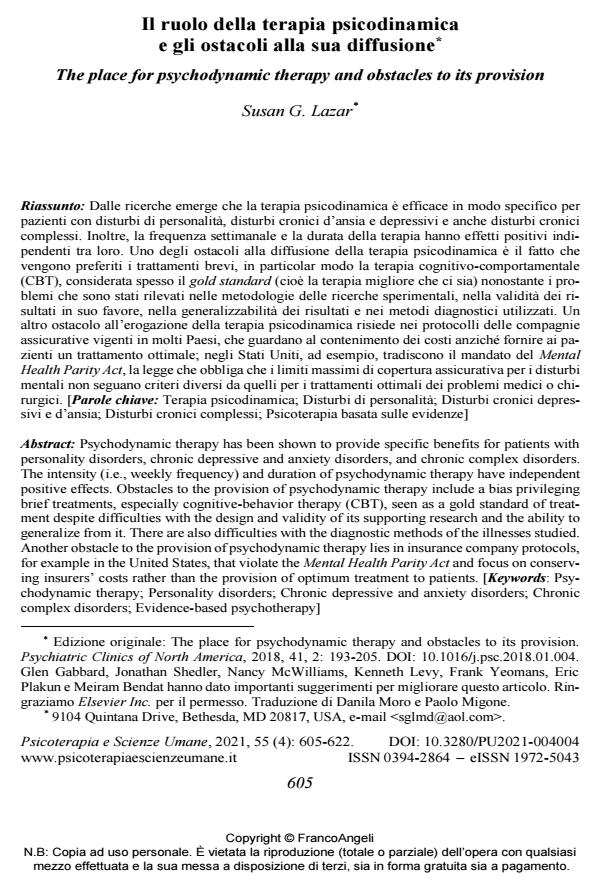Il ruolo della terapia psicodinamica e gli ostacoli alla sua diffusione
Titolo Rivista PSICOTERAPIA E SCIENZE UMANE
Autori/Curatori Susan G. Lazar
Anno di pubblicazione 2021 Fascicolo 2021/4
Lingua Italiano Numero pagine 18 P. 605-622 Dimensione file 366 KB
DOI 10.3280/PU2021-004004
Il DOI è il codice a barre della proprietà intellettuale: per saperne di più
clicca qui
Qui sotto puoi vedere in anteprima la prima pagina di questo articolo.
Se questo articolo ti interessa, lo puoi acquistare (e scaricare in formato pdf) seguendo le facili indicazioni per acquistare il download credit. Acquista Download Credits per scaricare questo Articolo in formato PDF

FrancoAngeli è membro della Publishers International Linking Association, Inc (PILA)associazione indipendente e non profit per facilitare (attraverso i servizi tecnologici implementati da CrossRef.org) l’accesso degli studiosi ai contenuti digitali nelle pubblicazioni professionali e scientifiche
Dalle ricerche emerge che la terapia psicodinamica è efficace in modo specifico per pazienti con disturbi di personalità, disturbi cronici d’ansia e depressivi e anche disturbi cronici complessi. Inoltre, la frequenza settimanale e la durata della terapia hanno effetti positivi indipendenti tra loro. Uno degli ostacoli alla diffusione della terapia psicodinamica è il fatto che vengono preferiti i trattamenti brevi, in particolar modo la terapia cognitivo-comportamentale (CBT), considerata spesso il gold standard (cioè la terapia migliore che ci sia) nonostante i problemi che sono stati rilevati nelle metodologie delle ricerche sperimentali, nella validità dei risultati in suo favore, nella generalizzabilità dei risultati e nei metodi diagnostici utilizzati. Un altro ostacolo all’erogazione della terapia psicodinamica risiede nei protocolli delle compagnie assicurative vigenti in molti Paesi, che guardano al contenimento dei costi anziché fornire ai pazienti un trattamento ottimale; negli Stati Uniti, ad esempio, tradiscono il mandato del Mental Health Parity Act, la legge che obbliga che i limiti massimi di copertura assicurativa per i disturbi mentali non seguano criteri diversi da quelli per i trattamenti ottimali dei problemi medici o chirurgici.
Parole chiave:Terapia psicodinamica; Disturbi di personalità; Disturbi cronici depressivi e d’ansia; Disturbi cronici complessi; Psicoterapia basata sulle evidenze
Susan G. Lazar, Il ruolo della terapia psicodinamica e gli ostacoli alla sua diffusione in "PSICOTERAPIA E SCIENZE UMANE" 4/2021, pp 605-622, DOI: 10.3280/PU2021-004004